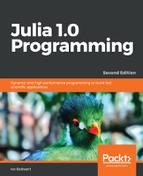Julia supports these types out of the box. The global constant im represents the square root of -1, so that 3.2 + 7.1im is a complex number with floating point coefficients, so it is of the type Complex{Float64}.
This is the first example of a parametric type in Julia. For this example, we can write this as Complex{T}, where type T can take a number of different type values, such as Int32, Int64, or Float64.
All operations and elementary functions, such as exp(), sqrt(), sinh(), real(), imag(), abs(), and so on, are also defined on complex numbers; for example, abs(3.2 + 7.1im) = 7.787810988975015.
If a and b are two variables that contain a number, use complex(a,b) to form a complex number with them. Rational numbers are useful when you want to work with exact ratios of integers, for example, 3//4, which is of type Rational{Int64}.
Again, comparisons and standard operations are defined: float() converts to a floating point number, and num() and den() gives the numerator and denominator. Both types work together seamlessly with all the other numeric types.
